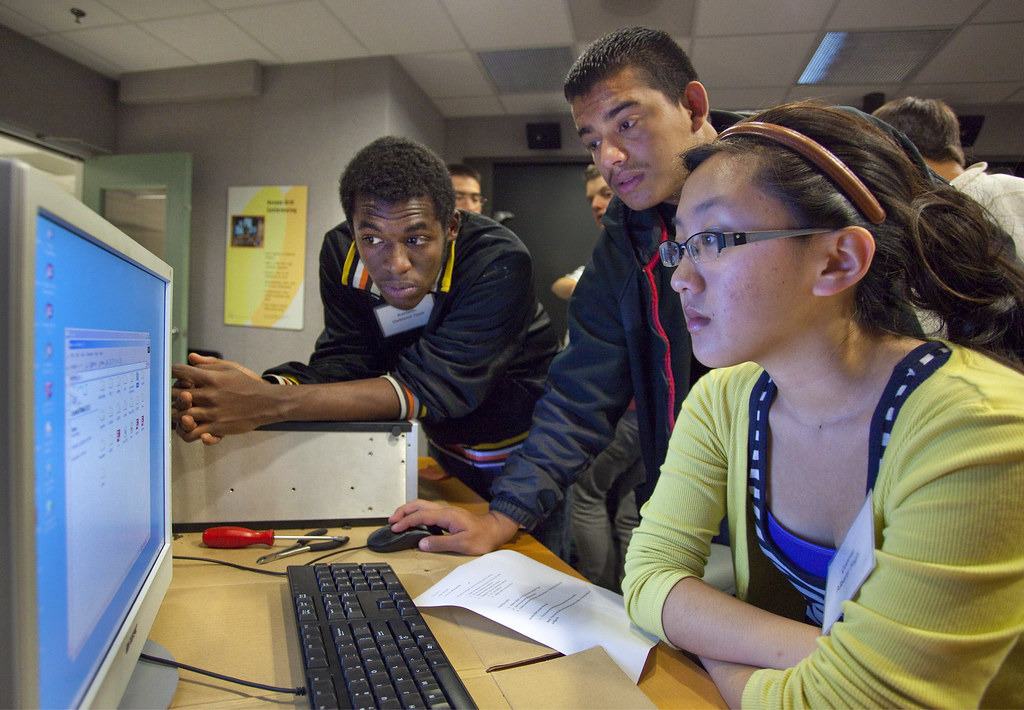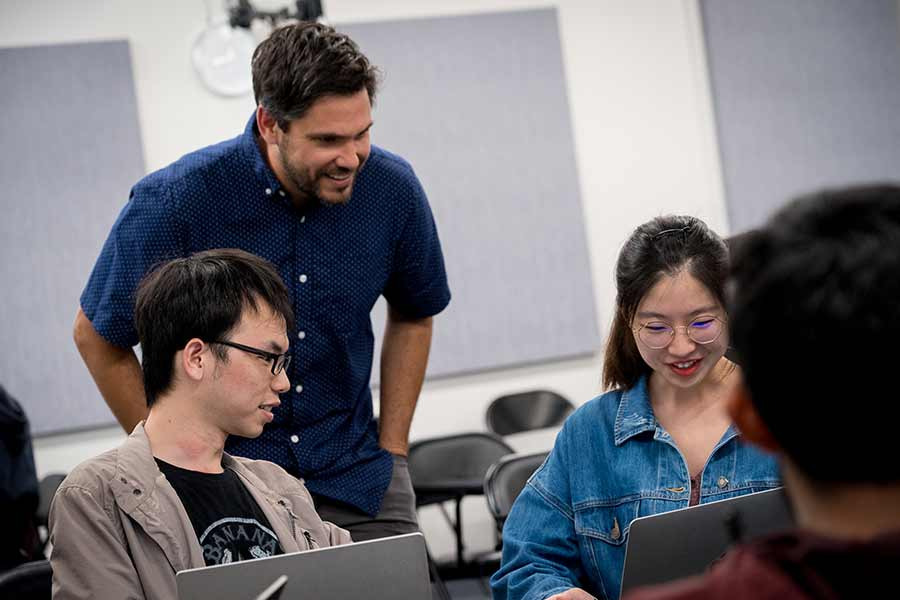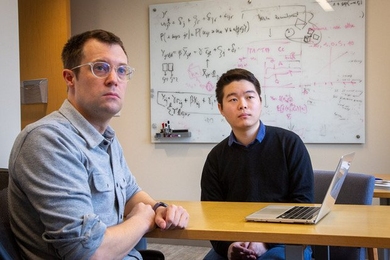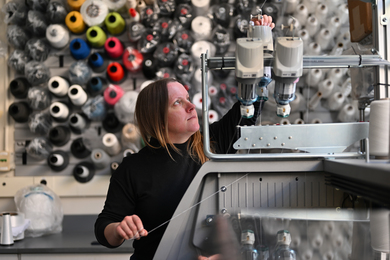- Job Search Advice
- Interviewing
- Login/Register
- Career Profiles and Employment Projections
- Computer and Information Research Scientists: Jobs, Career, Salary and Education Information

Computer and Information Research Scientists
Career, salary and education information.
What They Do : Computer and information research scientists invent and design new approaches to computing technology and find innovative uses for existing technology.
Work Environment : Most computer and information research scientists work full time. Some work more than 40 hours per week.
How to Become One : Most jobs for computer and information research scientists require a master’s degree in computer science or a related field. In the federal government, a bachelor’s degree may be sufficient for some jobs.
Salary : The median annual wage for computer and information research scientists is $131,490.
Job Outlook : Employment of computer and information research scientists is projected to grow 21 percent over the next ten years, much faster than the average for all occupations.
Related Careers : Compare the job duties, education, job growth, and pay of computer and information research scientists with similar occupations.
Following is everything you need to know about a career as a computer or information research scientist with lots of details. As a first step, take a look at some of the following jobs, which are real jobs with real employers. You will be able to see the very real job career requirements for employers who are actively hiring. The link will open in a new tab so that you can come back to this page to continue reading about the career:
Top 3 Computer Scientist Jobs
As a Computer Science Teacher, you will collaborate with teachers to create lesson plans and integrate the core curriculum into computer science projects. As you guide students through our exciting ...
Computer Science Teacher (Part Time) General Responsibilities: Under the supervision of the Director of Educational Development, plans and facilitates collaborative coding instructional sessions ...
Are you a Cryptanalytic Computer Scientist who is ready for a new challenge that will launch your career to the next level? * Tired of being treated like a company drone? * Tired of promised ...
See all Computer Scientist jobs
Top 3 Information Research Scientist Jobs
Research Scientist Job statement: The Research Scientist 's role is to develop novel molecular ... Identify and synthesize key information from internal and external knowledge bases to take charge ...
Research Scientist Position: Research Scientist Reports to : Head of Scientific Research Location ... Strong organizational & follow-up skills and the ability to handle sensitive information ...
... Research Scientist to join our RNA team. This position will play a pivotal role in the development ... information , citizenship status, uniformed service member or veteran status, or any other ...
See all Information Research Scientist jobs
What Computer and Information Research Scientists Do [ About this section ] [ To Top ]
Computer and information research scientists invent and design new approaches to computing technology and find innovative uses for existing technology. They study and solve complex problems in computing for business, science, medicine, and other fields.
Duties of Computer and Information Research Scientists
Computer and information research scientists typically do the following:
- Explore fundamental issues in computing and develop theories and models to address those issues
- Help scientists and engineers solve complex computing problems
- Invent new computing languages, tools, and methods to improve the way in which people work with computers
- Develop and improve the software systems that form the basis of the modern computing experience
- Design experiments to test the operation of these software systems
- Analyze the results of their experiments
- Publish their findings in academic journals and present their findings at conferences
Computer and information research scientists create and improve computer software and hardware.
Creating and improving software involves working with algorithms, which are sets of instructions that tell a computer what to do. Some computing tasks are very difficult and require complex algorithms. Computer and information research scientists try to simplify these algorithms to make computer systems as efficient as possible. The algorithms allow advancements in many types of technology, such as machine learning systems and cloud computing.
Computer and information research scientists design new computer architecture that improves the performance and efficiency of computer hardware. Their work often leads to technological advancements and efficiencies, such as better networking technology, faster computing speeds, and improved information security. In general, computer and information research scientists work at a more theoretical level than do other computer professionals.
Some computer scientists work with electrical engineers , computer hardware engineers , and other specialists on multidisciplinary projects. The following are examples of types of specialties for computer and information research scientists:
Data science. Computer and information research scientists write algorithms that are used to detect and analyze patterns in very large datasets. They improve ways to sort, manage, and display data. Computer scientists build algorithms into software packages that make the data easier for analysts to use. For example, they may create an algorithm to analyze a very large set of medical data in order to find new ways to treat diseases. They may also look for patterns in traffic data to help clear accidents faster.
Robotics . Some computer and information research scientists study how to improve robots. Robotics explores how a machine can interact with the physical world. Computer and information research scientists create the programs that control the robots. They work closely with engineers who focus on the hardware design of robots. Together, these workers test how well the robots do the tasks they were created to do, such as assemble cars or collect data on other planets.
Programming . Computer and information research scientists design new programming languages that are used to write software. The new languages make software writing more efficient by improving an existing language, such as Java, or by making a specific aspect of programming, such as image processing, easier.
Work Environment for Computer and Information Research Scientists [ About this section ] [ To Top ]
Computer and information research scientists hold about 33,500 jobs. The largest employers of computer and information research scientists are as follows:
Some scientists collaborate with engineers or other specialists or research scientists in different locations and do much of their work online.
Computer and Information Research Scientist Work Schedules
Most computer and information research scientists work full time.
How to Become a Computer or Information Research Scientist [ About this section ] [ To Top ]
Get the education you need: Find schools for Computer and Information Research Scientists near you!
Most jobs for computer and information research scientists require a master's degree in computer science or a related field. In the federal government, a bachelor's degree may be sufficient for some jobs.
Education for Computer and Information Research Scientists
Most computer and information research scientists need a master's degree in computer science or a related field, such as computer engineering. A master's degree usually requires 2 to 3 years of study after earning a bachelor's degree in a computer-related field, such as computer science or information systems.
Computer scientists who work in a specialized field may need knowledge of that field. For example, those working on biomedical applications may need to have taken some biology classes.
Advancement for Computer and Information Research Scientists
Some computer scientists may become computer and information systems managers .
Important Qualities for Computer and Information Research Scientists
Analytical skills. Computer and information research scientists must be organized in their thinking and analyze the results of their research to formulate conclusions.
Communication skills. Computer and information research scientists must communicate well with programmers and managers and be able to clearly explain their conclusions to people with no technical background. They often present their research at conferences.
Critical-thinking skills. Computer and information research scientists work on many complex problems.
Detail oriented. Computer and information research scientists must pay close attention to their work, because a small programming error can cause an entire project to fail.
Ingenuity. Computer and information research scientists must continually come up with innovative ways to solve problems, particularly when their ideas do not initially work as intended.
Logical thinking. Computer algorithms rely on logic. Computer and information research scientists must have a talent for reasoning.
Math skills. Computer and information research scientists must have knowledge of advanced math and other technical topics that are critical in computing.
Computer and Information Research Scientist Salaries [ About this section ] [ More salary/earnings info ] [ To Top ]
The median annual wage for computer and information research scientists is $131,490. The median wage is the wage at which half the workers in an occupation earned more than that amount and half earned less. The lowest 10 percent earned less than $74,210, and the highest 10 percent earned more than $208,000.
The median annual wages for computer and information research scientists in the top industries in which they work are as follows:
Job Outlook for Computer and Information Research Scientists [ About this section ] [ To Top ]
Employment of computer and information research scientists is projected to grow 21 percent over the next ten years, much faster than the average for all occupations.
About 3,300 openings for computer and information research scientists are projected each year, on average, over the decade. Many of those openings are expected to result from the need to replace workers who transfer to different occupations or exit the labor force, such as to retire.
Employment of Computer and Information Research Scientists
The research and development conducted by computer and information research scientists turn ideas into technology. As demand for new and better technology grows, demand for computer and information research scientists will grow as well.
Rapid growth in data collection by businesses will lead to an increased need for data-mining services. Computer and information research scientists will be needed to write algorithms that help businesses make sense of very large amounts of data.
A growing emphasis on cybersecurity also should lead to new jobs because computer and information research scientists will be needed to find innovative ways to prevent potential cyberattacks. In addition, an increase in demand for software may increase the need for computer and information research scientists who create new programming languages to make software writing more efficient.
Careers Related to Computer and Information Research Scientists [ About this section ] [ To Top ]
Computer and information systems managers.
Computer and information systems managers, often called information technology (IT) managers or IT project managers, plan, coordinate, and direct computer-related activities in an organization. They help determine the information technology goals of an organization and are responsible for implementing computer systems to meet those goals.
Computer Hardware Engineers
Computer hardware engineers research, design, develop, and test computer systems and components such as processors, circuit boards, memory devices, networks, and routers.
Computer Network Architects
Computer network architects design and build data communication networks, including local area networks (LANs), wide area networks (WANs), and Intranets. These networks range from small connections between two offices to next-generation networking capabilities such as a cloud infrastructure that serves multiple customers.
Computer Programmers
Computer programmers write and test code that allows computer applications and software programs to function properly. They turn the program designs created by software developers and engineers into instructions that a computer can follow.
Computer Systems Analysts
Computer systems analysts, sometimes called systems architects, study an organization's current computer systems and procedures, and design solutions to help the organization operate more efficiently and effectively. They bring business and information technology (IT) together by understanding the needs and limitations of both.
Database Administrators
Database administrators (DBAs) use specialized software to store and organize data, such as financial information and customer shipping records. They make sure that data are available to users and secure from unauthorized access.
Data Scientists
Data scientists use analytical tools and techniques to extract meaningful insights from data.
Information Security Analysts
Information security analysts plan and carry out security measures to protect an organization's computer networks and systems. Their responsibilities are continually expanding as the number of cyberattacks increases.
Network and Computer Systems Administrators
Computer networks are critical parts of almost every organization. Network and computer systems administrators are responsible for the day-to-day operation of these networks.
Software Developers
Software developers are the creative minds behind computer programs. Some develop the applications that allow people to do specific tasks on a computer or another device. Others develop the underlying systems that run the devices or that control networks.
Web Developers
Web developers design and create websites. They are responsible for the look of the site. They are also responsible for the site's technical aspects, such as its performance and capacity, which are measures of a website's speed and how much traffic the site can handle. In addition, web developers may create content for the site.
Top Executives
Top executives devise strategies and policies to ensure that an organization meets its goals. They plan, direct, and coordinate operational activities of companies and organizations.
More Computer and Information Research Scientist Information [ About this section ] [ To Top ]
For more information about computer and information research scientists, visit
Association for Computing Machinery
IEEE Computer Society
For information about opportunities for women pursuing information technology careers, visit
National Center for Women & Information Technology
A portion of the information on this page is used by permission of the U.S. Department of Labor.
Explore more careers: View all Careers or the Top 30 Career Profiles
Search for jobs:.
What Is a Computer Information Researcher?

Ashley Reid
Contributing Writer
Learn about our editorial process .
Updated March 27, 2024

ComputerScience.org is an advertising-supported site. Featured or trusted partner programs and all school search, finder, or match results are for schools that compensate us. This compensation does not influence our school rankings, resource guides, or other editorially-independent information published on this site.
Are you ready to discover your college program?
Computer information researchers create new and emerging technologies. They conduct experiments and analyze data to find solutions to diverse computing problems.
As tech leaders, these researchers hold prestigious positions that often come with higher-than-average salaries and high demand. Many pursue master's and doctoral degrees in computer science before becoming research scientists.
Computer information researchers work in diverse industries, including governmental agencies, software systems design, and manufacturing. Responsibilities are similar across sectors: These researchers typically work in teams with other researchers, IT professionals, and engineers to develop new tech solutions.
Keep reading to learn more about how to become a computer information researcher, what the job entails, and the career outlook.
History of Computer Information Researchers
Computer information researchers have been at the forefront of the computer science industry since its inception. While not called computer and information researchers at the time, notable mathematicians and inventors have made groundbreaking technical discoveries since the 1800s. People like Charles Babbage and Ada Lovelace helped lay the foundations for computer science, just like modern computer information researchers develop emerging technologies.
Computer information research grew more popular in the 1940s, driven by post-World War II innovations. Even then, computer science was just beginning to flourish. The field saw a boom in the following decades, developing several specializations like computer and information research.
What Does a Computer Information Researcher Do?
Computer and information research scientists spur technological innovation across many industries. They identify computing problems and help develop solutions. These professionals focus their efforts on creating new technologies, becoming the driving force of technological advances.
Creating new technology poses several challenges. Computer information researchers must navigate prior research, identify underexplored topics, and provide solutions where others find none. They may also face competition while developing new software systems or programming languages.
Computer and information research scientists can choose from several specialties, like robotics, artificial intelligence, or programming. They often work in teams with other computer scientists and engineers.
As industry trailblazers, these researchers hold diverse skill sets. The lists below include typical skills that help computer information researchers excel in their positions.
Key Soft Skills for Computer Information Researchers
- Organization: Understanding previous research, developing methodologies, and recording data requires exceptional organization. Researchers must also present their findings in organized, logical formats.
- Analysis: Research and analysis are interlinked. Spending hours conducting experiments and collecting data calls for analytical and critical thinking skills.
- Communication: Computer information researchers need communication skills for every stage of their work. They may discuss computing problems with company managers or industry leaders, then communicate a research plan with their team. These professionals also use written communication to publish their research in journals.
- Collaboration: Innovation usually results from collaboration. Computer and information researchers may work alongside engineers, fellow researchers, or industry experts. For example, researchers developing solutions for the healthcare industry often collaborate with and gather insight from medical professionals.
Key Hard Skills for Computer Information Researchers
- Programming: Computer information researchers need expert-level programming abilities. They should know multiple languages, like Java, C++, and Python. Research scientists may help develop new programming languages.
- Discrete Mathematics: Discrete mathematics is at the core of computer science. Computer information researchers use discrete math when working with or creating algorithms and software systems.
- Data Science: Researchers handle vast amounts of data. Using data science principles to extract and analyze information can help research scientists work efficiently.
- Machine Learning: Because machine learning and artificial intelligence are popular across several technology subfields, familiarity with these concepts may benefit aspiring computer information researchers.
A Day in the Life of a Computer Information Researcher
A computer information researcher's daily work typically depends on their specialty and industry.
Most computer information researchers spend time on the following:
- Communicating with managers or clients to understand computing problems
- Creating solutions, including developing new software or technology
- Executing experiments and collecting data
- Analyzing reports and making improvements on current systems
- Publishing research findings
Computer information researchers analyze and evaluate the problems and shortcomings within an organization and provide computing solutions to fix them. These professionals develop new computing technologies and improve existing systems and programs.
Professionals working in computer information research need to have a strong grasp of foundational computer science that can help business, medicine, science, and other industries with groundbreaking computing technologies.
The daily tasks of a computer information researcher include studying user needs and developing technologies to address them, measuring the performance of new programs, and writing technical reports for conferences.
Computer information research and similar occupations have a high demand that the U.S. Bureau of Labor Statistics (BLS) projects to grow by 22% from 2020-2030.
What Education Do Computer Information Researchers Need?
The minimum education required to become a computer information researcher is a master's degree in information technology, computer science, or a similar field. A bachelor's degree helps aspiring computer information researchers develop the necessary hard skills for this profession.
Some information researchers may need to take additional classes to gain specialized knowledge. For instance, researchers interested in medicine or biotechnology may need to complete courses in biology or chemistry
Students aiming for federal government jobs may have to take law, public administration, or political science classes. Certain researcher roles may seek candidates with doctoral-level education in fields like information technology or data science.
Some professionals may supplement their college or university education with coding bootcamps . These compact, intensive programs provide career-oriented training for specific roles and last anywhere from two weeks to six months. Computer information researchers also benefit from continuing education programs throughout their careers.

Match me with a bootcamp.
Find programs with your skills, schedule, and goals in mind.
How Much Experience Do Computer Information Researchers Need?
All researcher roles typically call for advanced degrees and at least five years of work experience. Having a portfolio of work is essential when applying for computer research scientist roles.
Data science, machine learning, and computer science bootcamps provide technical skills with the help of practical projects. New graduates and entry-level professionals may also pursue internships to gain valuable experience.
Certifications
Although information researcher roles do not require certifications, these credentials verify skills and competency to demonstrate specialized knowledge of the field. Some certifications require renewal every 2-5 years.
Computer information researchers can pursue the following certifications to boost their career opportunities.
Certified Computer Scientist : Offered by the ICCP,this certification demonstrates proficiency in innovation and creating new computer applications to foster growth in technology and business. Certification costs range from $250-$4,500. Renewal is every three years.
Microsoft Certifications : Microsoft offers various certifications for software engineers, network engineers, and data scientists. The exam fee is $165.
Certified Analytics Professional : This vendor-neutral certification validates a computer scientist's ability to translate complex data into useful actions.The CAP exam fee is $695 for non-members and $495 for INFORMS members.
How Do I Become a Computer Information Researcher?
There may be several career paths to becoming a computer information researcher. Candidates first need to earn a four-year bachelor's degree in computer science, information technology, software engineering, or a related field. Next, they should secure internship opportunities and then build experience with entry-level jobs.
A master's degree in data science, computer science, or a related field takes another two years. Enrollees may complete online, accelerated programs in as little as 12 months, while part-time students can take up to five years to obtain their degree.
Bootcamps and certifications are not necessary for candidates with advanced degrees, though they help develop specialized skills in certain focus areas. A candidate looking to pursue academic research roles needs a Ph.D. in a computer-related field.
Steps to Becoming a Computer Information Researcher
Master's degree path.
- Earn a Bachelor's Degree : Since information research is not typically offered as a major or concentration, aspiring computer information researchers can get bachelor's degrees in related subjects, such as computer science, data science, or computer engineering.
- Build Relevant Job Experience : After earning a bachelor's degree, professionals can build experience as research interns or entry-level computing research assistants.
- Get a Master's Degree : A graduate degree in a computer-related field is often vital for a career in information research. A master's degree typically takes two years to complete.
- Choose a Specialty : Aspiring information researchers should aim to specialize in big data, human-computer interaction, data science, machine learning, or a similar concentration to improve their chances of landing a computer information researcher job.
- Consider Getting an Advanced Degree : Senior roles in computing research may call for advanced degrees like a Ph.D. These programs require investing significant time and money — professionals must carefully consider their career goals before committing to higher education.
Computer Information Researcher Salary and Career Outlook
The career outlook for computer information researchers is positive. The U.S. Bureau of Labor Statistics (BLS) projects a 22% job growth between 2020 and 2030. This means computer information research positions are growing much faster than the average growth projection for all jobs.
The BLS also reports the median annual salary for computer and information research scientists was $131,490 as of 2021, with the highest 10 percent of salaries averaging $208,000. Factors that can impact earning potential include experience, industry, and location.
For example, the BLS reports metropolitan areas with large populations pay the highest average salaries for computer and information researchers. Oregon, Arizona, and Texas top the list of highest-paying states for these professionals.
High-employing industries for computer information researchers include computer systems design and scientific research and development. The federal executive branch hires the most computer information researchers, but the average salary for these workers falls below the median.
The highest-paying industries include information services, computer systems design, and semiconductor and other electronic component manufacturing. Average annual salaries in these sectors range from $169,640 to $188,660.
Annual Median Salary
Source: Bureau of Labor Statistics
How to Become a Computer Information Researcher
Computer information researchers hold prestigious positions in the tech industry. Although some employers hire applicants with only a bachelor's degree, most positions require a master's degree. Some employers may even prefer a doctoral degree.
Pursuing a bachelor's and a master's degree typically takes 5-6 years of full-time study. Relevant majors for computer and information researchers include computer science, information technology, and information systems . Candidates interested in top-paying positions should consider a doctoral degree in information systems or a similar field. These programs typically take an extra 4-5 years of full-time study.
Though coding bootcamps can offer faster, more affordable training for tech jobs, most employers expect researcher applicants to hold more extensive training from degree-granting programs. However, computer information researchers can supplement their college education with programming or data science bootcamps.
These professionals can also pursue industry certifications that align with their research focus. Options include Cisco's CCIE data center credential and SAS's advanced programming professional certification .
Learn more about potential certifications and degree programs for computer information researchers below.
Additional Resources
Similar specializations and career paths.
Becoming a computer information researcher requires significant training. Current computer information researchers or recent graduates can apply their diverse skill sets to several career paths, working as analysts or software developers. With experience, computer information researchers may qualify for managerial positions.
The list below includes a few career paths available to current and aspiring computer information researchers.
- Computer and Information Systems Managers : Computer and information systems managers work as chief information officers, IT directors, chief technology officers, and IT security managers. Typical duties for managers include leading tech teams and creating plans to improve companies' computer and information systems. They may also research new technologies and oversee software installation.
- Computer Hardware Engineers : Hardware engineers design physical computer components, including routers, circuit boards, and processors. They also research and test computer equipment, using this data to update systems or design new ones. Hardware engineers often work in the tech industry. They may also find work designing computer systems for medical devices or household appliances.
- Network Architects : Also called network engineers, network architects design computer networks. They research new technologies to design and improve effective data communication networks to meet company goals. These professionals often work in tech, telecommunications, and management.
- Software Developers : Software developers create software to meet client needs. They may focus on applications or systems software — in both cases, they analyze current programs and research potential upgrades. These professionals create and maintain software, often working in teams with other IT professionals.
- Computer Systems Analysts : Businesses may hire computer systems analysts as in-house employees or as contractors. These analysts help companies find more efficient IT solutions. They examine current IT systems, research potential upgrades, and install new systems.
Resources for Computer Information Researchers
Explore the professional organizations and frequently asked questions below. Aspiring computer information researchers can use these resources to plan their career paths and seek professional support.
Professional Organizations for Computer Information Researchers
- Association for Information Science and Technology (ASIS&T): ASIS&T serves professionals from diverse industries, including engineering, computer science, and medicine. It promotes information science research to develop practical applications. Members can take part in career development, networking, and mentorship opportunities.
- Computing Research Association (CRA): CRA grants membership to labs, academic departments, and professional societies. Together, they advocate for the research community. Members can participate in conferences and career-building workshops.
- Institute of Electrical and Electronics Engineers (IEEE): Dating back to 1884, IEEE has become a worldwide organization. It establishes international standards and publishes technical literature. IEEE members join local communities to share research and emerging technologies. They can also attend conferences and continuing education courses.
- Association for Information Systems (AIS): The global AIS community connects information systems professionals, including researchers and teachers. Members can use the AIS virtual library to broaden their research. They can also network and find job opportunities through AIS career services.
Computer Information Researcher Questions
How long does it take to become a computer information scientist.
Most computer information research scientist positions require a master's degree. Full-time students generally spend four years on a bachelor's degree and 1-2 years on a master's. Some researchers hold a doctorate, which requires 4-5 more years of full-time study.
How do you become a computer information scientist?
To qualify for computer and information scientist jobs, professionals need at least a bachelor's degree in computer science, information systems, or a related field. Most professionals also hold graduate degrees. They may supplement their education with technical certifications or bootcamps.
How much does a computer information scientist make?
The BLS reports that computer and information research scientists earn an annual median salary of $131,490 as of 2021. Factors like industry and location influence earning potential.
Is it hard to be a computer information scientist?
Like many technical careers, computer information research scientist jobs can be difficult, requiring extensive research and innovative problem-solving. Still, the career can be rewarding for people passionate about computer science and developing new technology.
Reviewed by:
Darnell Kenebrew is a first-generation graduate from San Francisco State University's class of 2020. He graduated with a bachelor's in computer science, which helped him kick off a career in tech and pursue roles in data and engineering. Currently, he is a data analytics engineer at Meta and an executive captain for COOP Careers — a nonprofit for overcoming underemployment. Kenebrew strongly believes in giving people a chance and that everyone should have an equal opportunity within the job market. He believes that COOP Careers helps this equality materialize. Kenebrew is passionate about how the industry is shaped with data and how data can be leveraged in many aspects of business decisions to meet goals. In addition, he is passionate about inclusion, community, education, and using data for good. He hopes that he can pivot business decisions to make a positive, meaningful impact and that his work will positively impact end-users and meet business goals. Darnell Kenebrew is a paid member of the Red Ventures Education Integrity Network. Page last reviewed July 25, 2022
Featured Image: Getty Image
Recommended Reading
Take the next step toward your future.
Discover programs you’re interested in and take charge of your education.

Job Outlook for: Computer and Information Research Scientists
SOC: 15-1111 OOH: U003
- Job Outlook for Computer and Information Research Scientists
- Pay for Computer and Information Research Scientists
- What do Computer and Information Research Scientists do all day
- The work environment
- How to become one
Employment Outlook for Computer and Information Research Scientists
Employment of computer and information research scientists is projected to grow 19 percent from 2016 to 2026, much faster than the average for all occupations. However, because it is a small occupation, the fast growth will result in only about 5,400 new jobs over the 10-year period.
The research and development work of computer and information research scientists turns ideas into industry-leading technology. As demand for new and better technology grows, demand for computer scientists will grow as well.
Rapid growth in data collection by businesses will lead to an increased need for data-mining services. Computer scientists will be needed to write algorithms that help businesses make sense of very large amounts of data. With this information, businesses understand their consumers better, making the work of computer and information research scientists increasingly vital.
A growing emphasis on cybersecurity also should lead to new jobs, because computer scientists will be needed to find innovative ways to prevent cyberattacks.
In addition, an increase in demand for software may increase the need for computer scientists who create new programming languages to make software writing more efficient.
Job Prospects
Computer and information research scientists are likely to have excellent job prospects.
For applicants seeking employment in a specialized field, such as finance or biology, knowledge of that field, along with a computer science degree, may be helpful in getting a job.
Typical Pay for Computer and Information Research Scientists
The median annual wage for computer and information research scientists was $111,840 in May 2016. The median wage is the wage at which half the workers in an occupation earned more than that amount and half earned less. The lowest 10 percent earned less than $64,950, and the highest 10 percent earned more than $169,680.
In May 2016, the median annual wages for computer and information research scientists in the top industries in which they worked were as follows:
Most computer and information research scientists work full time. About 3 in 10 worked more than 40 hours per week in 2016.
What Computer and Information Research Scientists Do All Day
Computer and information research scientists invent and design new approaches to computing technology and find innovative uses for existing technology. They study and solve complex problems in computing for business, science, medicine, and other fields.
Computer and information research scientists typically do the following:
- Explore fundamental issues in computing and develop theories and models to address those issues
- Help scientists and engineers solve complex computing problems
- Invent new computing languages, tools, and methods to improve the way in which people work with computers
- Develop and improve the software systems that form the basis of the modern computing experience
- Design experiments to test the operation of these software systems
- Analyze the results of their experiments
- Publish their findings in academic journals and present their findings at conferences
Computer and information research scientists create and improve computer software and hardware.
Creating and improving software involves working with algorithms, which are sets of instructions that tell a computer what to do. Some computing tasks are very difficult and require complex algorithms. Computer and information research scientists try to simplify these algorithms to make computer systems as efficient as possible. The algorithms allow advancements in many types of technology, such as machine learning systems and cloud computing.
Computer and information research scientists design new computer architecture that improves the performance and efficiency of computer hardware. Their work often leads to technological advancements and efficiencies, such as better networking technology, faster computing speeds, and improved information security. In general, computer and information research scientists work at a more theoretical level than do other computer professionals.
Some computer scientists work with electrical engineers , computer hardware engineers , and other specialists on multidisciplinary projects. The following are examples of types of specialties for computer and information research scientists:
Data science. Computer and information research scientists write algorithms that are used to detect and analyze patterns in very large datasets. They improve ways to sort, manage, and display data. Computer scientists build algorithms into software packages that make the data easier for analysts to use. For example, they may create an algorithm to analyze a very large set of medical data in order to find new ways to treat diseases. They may also look for patterns in traffic data to help clear accidents faster.
Robotics . Some computer and information research scientists study how to improve robots. Robotics explores how a machine can interact with the physical world. Computer and information research scientists create the programs that control the robots. They work closely with engineers who focus on the hardware design of robots. Together, these workers test how well the robots do the tasks they were created to do, such as assemble cars or collect data on other planets.
Programming . Computer and information research scientists design new programming languages that are used to write software. The new languages make software writing more efficient by improving an existing language, such as Java, or by making a specific aspect of programming, such as image processing, easier.
Work Environment for Computer and Information Research Scientists
Computer and information research scientists held about 27,900 jobs in 2016. The largest employers of computer and information research scientists were as follows:
Some computer scientists may work on teams with electrical engineers , computer hardware engineers , and other specialists on multidisciplinary projects.
Work Schedules
How to become a computer and information research scientist.
Most jobs for computer and information research scientists require a master’s degree in computer science or a related field. In the federal government, a bachelor’s degree may be sufficient for some jobs.
Most computer and information research scientists need a master’s degree in computer science or a related field, such as computer engineering. A master’s degree usually requires 2 to 3 years of study after earning a bachelor’s degree in a computer-related field, such as computer science or information systems.
Computer scientists who work in a specialized field may need knowledge of that field. For example, those working on biomedical applications may need to have taken some biology classes.
Advancement
Some computer scientists may become computer and information systems managers .
Important Qualities
Analytical skills. Computer and information research scientists must be organized in their thinking and analyze the results of their research to formulate conclusions.
Communication skills. Computer and information research scientists must communicate well with programmers and managers and be able to clearly explain their conclusions to people with no technical background. They often present their research at conferences.
Critical-thinking skills. Computer and information research scientists work on many complex problems.
Detail oriented. Computer and information research scientists must pay close attention to their work, because a small programming error can cause an entire project to fail.
Ingenuity. Computer and information research scientists must continually come up with innovative ways to solve problems, particularly when their ideas do not initially work as intended.
Logical thinking. Computer algorithms rely on logic. Computer and information research scientists must have a talent for reasoning.
Math skills. Computer and information research scientists must have knowledge of advanced math and other technical topics that are critical in computing.
"Computer and Information Research Scientists" SOC: 15-1111 OOH Code: U003

- Create new account
Computer or Information Research Scientist
Computer and information research scientists design innovative uses for new and existing technology. They study and solve complex problems in computing for business, science, medicine, and other fields.
Computer and information research scientists typically do the following:
- Explore problems in computing and develop theories and models to address those problems
- Collaborate with scientists and engineers to solve complex computing problems
- Determine computing needs and system requirements
- Develop new computing languages, software systems, and other tools to improve how people work with computers
- Design and conduct experiments to test the operation of software systems, frequently using techniques from data science and machine learning
- Analyze the results of their experiments
- Write papers for publication and present research findings at conferences
Computer and information research scientists create and improve computer software and hardware.
To create and improve software, computer and information research scientists work with algorithms: sets of instructions that tell a computer what to do. Some difficult computing tasks require complex algorithms, which these scientists simplify to make computer systems as efficient as possible. These simplified algorithms may lead to advancements in many types of technology, such as machine learning systems and cloud computing.
To improve computer hardware, these scientists design computer architecture. Their work may result in increased efficiencies, such as better networking technology, faster computing speeds, and improved information security.
The following are examples of specialties for computer and information research scientists:
Programming. Some computer and information research scientists study and design new programming languages that are used to write software. New languages make software writing efficient by improving an existing language, such as Java, or by simplifying a specific aspect of programming, such as image processing.
Robotics . These scientists study the development and application of robots. They explore how a machine can interact with the physical world. For example, they may create systems that control the robots or design robots to have features such as information processing or sensory feedback.
Some computer and information research scientists work on multidisciplinary projects with electrical engineers, computer hardware engineers, and other specialists. For example, robotics specialists and engineers who design robots’ hardware may team up to test whether the robots complete tasks as intended.
Computer and information research scientists held about 33,500 jobs in 2021. The largest employers of computer and information research scientists were as follows:
Some scientists collaborate with engineers or other specialists or research scientists in different locations and do much of their work online.
Work Schedules
Most computer and information research scientists work full time.
Computer and information research scientists typically need at least a master’s degree in computer science or a related field. In the federal government, a bachelor’s degree may be sufficient for some jobs.
Computer and information research scientists typically need a master’s or higher degree in computer science or a related field, such as computer engineering. A master’s degree usually requires 2 to 3 years of study after earning a bachelor’s degree in a computer-related field, such as computer science or information systems. Some employers prefer to hire candidates who have a Ph.D. Others, such as the federal government, may hire candidates who have a bachelor’s degree in computer and information technology.
Computer and information research scientists who work in a specialized field may need knowledge of that field. For example, those working on biomedical applications may need to have studied biology.
Advancement
Some computer and information research scientists advance to become computer and information systems managers.
Computer and information research scientists typically have an interest in the Building, Thinking and Creating interest areas, according to the Holland Code framework. The Building interest area indicates a focus on working with tools and machines, and making or fixing practical things. The Thinking interest area indicates a focus on researching, investigating, and increasing the understanding of natural laws. The Creating interest area indicates a focus on being original and imaginative, and working with artistic media.
If you are not sure whether you have a Building or Thinking or Creating interest which might fit with a career as a computer and information research scientist, you can take a career test to measure your interests.
Computer and information research scientists should also possess the following specific qualities:
Analytical skills. Computer and information research scientists must be organized in their thinking and analyze the results of their research to formulate conclusions.
Communication skills. Computer and information research scientists must communicate well with programmers and managers and be able to clearly explain their conclusions to people with no technical background. They often write for academic journals and similar publications.
Critical-thinking skills. Computer and information research scientists work on many complex problems.
Detail oriented. Computer and information research scientists must pay close attention to their work, because a small error can cause an entire project to fail.
Ingenuity. Computer and information research scientists must continually come up with innovative ways to solve problems, particularly when their ideas do not initially work as intended.
Logical thinking . Computer algorithms rely on logic. Computer and information research scientists must have a talent for reasoning.
Math skills. Computer and information research scientists must have knowledge of advanced math and other technical topics that are critical in computing.
The median annual wage for computer and information research scientists was $131,490 in May 2021. The median wage is the wage at which half the workers in an occupation earned more than that amount and half earned less. The lowest 10 percent earned less than $74,210, and the highest 10 percent earned more than $208,000.
In May 2021, the median annual wages for computer and information research scientists in the top industries in which they worked were as follows:
Employment of computer and information research scientists is projected to grow 21 percent from 2021 to 2031, much faster than the average for all occupations.
About 3,300 openings for computer and information research scientists are projected each year, on average, over the decade. Many of those openings are expected to result from the need to replace workers who transfer to different occupations or exit the labor force, such as to retire.
The research and development conducted by computer and information research scientists turn ideas into technology. As demand for new and better technology grows, demand for computer and information research scientists will grow as well.
Rapid growth in data collection by businesses will lead to an increased need for data-mining services. Computer and information research scientists will be needed to write algorithms that help businesses make sense of very large amounts of data.
A growing emphasis on cybersecurity also should lead to new jobs because computer and information research scientists will be needed to find innovative ways to prevent potential cyberattacks. In addition, an increase in demand for software may increase the need for computer and information research scientists who create new programming languages to make software writing more efficient.
For more information about computer and information research scientists, visit
Association for Computing Machinery
Computing Research Association
IEEE Computer Society
For information about opportunities for women pursuing information technology careers, visit
National Center for Women & Information Technology
To find job openings for computer and information research scientists in the federal government, visit
Where does this information come from?
The career information above is taken from the Bureau of Labor Statistics Occupational Outlook Handbook . This excellent resource for occupational data is published by the U.S. Department of Labor every two years. Truity periodically updates our site with information from the BLS database.
I would like to cite this page for a report. Who is the author?
There is no published author for this page. Please use citation guidelines for webpages without an author available.
I think I have found an error or inaccurate information on this page. Who should I contact?
This information is taken directly from the Occupational Outlook Handbook published by the US Bureau of Labor Statistics. Truity does not editorialize the information, including changing information that our readers believe is inaccurate, because we consider the BLS to be the authority on occupational information. However, if you would like to correct a typo or other technical error, you can reach us at [email protected] .
I am not sure if this career is right for me. How can I decide?
There are many excellent tools available that will allow you to measure your interests, profile your personality, and match these traits with appropriate careers. On this site, you can take the Career Personality Profiler assessment, the Holland Code assessment, or the Photo Career Quiz .
Get Our Newsletter
Computer & Information Research Scientists

Also called: Computer Scientist, Computer Specialist, Control System Computer Scientist, Research Scientist
- Analyze problems to develop solutions involving computer hardware and software.
- Apply theoretical expertise and innovation to create or apply new technology, such as adapting principles for applying computers to new uses.
- Assign or schedule tasks to meet work priorities and goals.
Engineering and Technology
- computers and electronics
- product and service development
Math and Science
- arithmetic, algebra, geometry, calculus, or statistics
Arts and Humanities
- English language
Basic Skills
- thinking about the pros and cons of different ways to solve a problem
- listening to others, not interrupting, and asking good questions
Problem Solving
- noticing a problem and figuring out the best way to solve it
People and Technology Systems
- thinking about the pros and cons of different options and picking the best one
- figuring out how a system should work and how changes in the future will affect it
- communicate by speaking
- listen and understand what people say
Ideas and Logic
- make general rules or come up with answers from lots of detailed information
- use rules to solve problems
- choose the right type of math to solve a problem
- add, subtract, multiply, or divide
Personality
People interested in this work like activities that include ideas, thinking, and figuring things out.
They do well at jobs that need:
- Analytical Thinking
- Cooperation
- Attention to Detail
- Independence
- Achievement/Effort
You might use software like this on the job:
Development environment software
Presentation software, analytical or scientific software.
Get started on your career:
Job Outlook
Explore more.
- Computer Systems Engineers/Architects
- Data Scientists
- Mathematicians
- Operations Research Analysts
- Software Developers
You might like a career in one of these industries:
- Professional, Science, & Technical
Print this Page
Search careers with key words.
- Type a title or code for matches
- No quick matches found
- Search for career results
Browse careers by industry
- computer hardware
- investigative
- computer system
- organizational goal
- information technology

Also called
Computer and information research scientists are also called:
- Computer Scientist
- Computer Specialist
- Control System Computer Scientist
- Research Scientist
- Scientific Programmer Analyst
Hot Technology
is a hot technology.
Hot technologies are software skills that employers often ask for in job ads.
is in demand for this career.
Employers ask for this software skill in percent of job ads for this career.
Job Preparation
Extensive job preparation is needed for computer and information research scientists .
Extensive skill, knowledge, and experience are needed for these careers. Many require more than five years of experience. For example, surgeons must complete four years of college and an additional five to seven years of specialized medical training to be able to do their job.
Employees may need some on-the-job training. However, the person will usually have the needed skills, knowledge, work-related experience, and training before starting the job.
Most of these careers need a graduate school education. For example, they may require a master's degree, and some require a Ph.D., M.D., or J.D. (law degree).
Job Zone Five
Find training.
Train for careers like computer and information research scientists .
Learn about training available in your area.
Apprenticeships
Find the apprenticeship that's right for you!
Have a career path or location in mind? Visit Apprenticeship.gov to find apprenticeship opportunities near you.
It's a bright outlook for computer and information research scientists !
This career will grow rapidly in the next few years.
Explore more Bright Outlook careers
Local Salary Info
See salary information for computer and information research scientists in your area.
Enter your ZIP code or state below to get started:
Job Listings
Find job openings for computer and information research scientists .
Use listings to apply for jobs related to your career, or find local and national job banks.

Information Scientist Career Overview & Outlook
Information scientist holds a critical position in any organization. They are the people who directly collect and maintain the organization’s databases to ensure that information is always safe and available to use.
If you are interested in this field and aspire to be an information scientist, this article is for you. It covers everything about the job description, education requirements, skills, and everything you need to know to succeed in this field.
Keep reading to get the useful information!
Job Description
The information scientist is no longer strange in the context of the strong development of today’s technology world. So what is an information scientist?
Where do they work, and what are their responsibilities? To help you answer those questions, I will provide you with some reviews below.
What is an Information Scientist?
Information scientists are people who undertake data research, statistics, and information repositories. Then, they find ways to make this information valuable and accessible to users.
Information science is the practice, collection, storage, and retrieval of information. It relates to technologies and services that transfer data between organizations and individuals.
You will be in charge of transmitting knowledge, organizing, and retrieving the necessary information if you want to do this job.
Duties and Responsibilities

Information scientists manage and oversee tasks such as collecting and distributing critical information within one or more organizations to users. Their primary duties and responsibilities include:
- Organize, categorize, evaluate, and distribute informational data in a variety of formats and categories
- Build a database system
- Ensure information is updated and renewed regularly.
- Comply with and apply specific data protection laws
- Intranet development support
- Respond to Freedom of Information (FOI) issues and requests.
- Check, and monitor information and internal requirements.
- Maintain statistical and financial records
- Write various report types.
Where Do Information Scientists Work?
Information scientists often work in corporate offices, business organizations, and factories. They spend time communicating and researching in the archives with their colleagues or groups.
Information scientists will work in different contexts and needs. For example, some people hold research roles in universities, while others support jobs in hospitals or medical facilities.
Also, they can be an excellent help for executives or those looking for crucial data information.
Education Requirements
Any career requires primary education, and information science is no exception. Specific information scientist educational requirements will be in the section below. Continue reading to understand!

Qualifications and Training
Equipping yourself with a background in information science or information and library studies is essential to getting off to a good start in this field. It gives you a better competitive edge and attracts the attention of employers.
You can enter this industry with any skill and degree, depending on the industry you are pursuing. For example, a degree in history is the right choice if you want to hold a senior position in the historical database management industry.
Many employers often require candidates to have an undergraduate or postgraduate degree from the Chartered Institute of Library and Information Professionals ( CILIP ).
That’s why I recommend that you carefully check the list of qualifications on the CILIP website to better prepare for your career.
Also, consider applying for positions related to other areas, such as information technology, data governance, and intensive training. It is the ideal solution for you to improve your specialized knowledge and gain valuable experience.
There are several experience requirements to become an information scientist. The thing is that an internship will give you practical learning and experience opportunities to add to your resume.
Most employers give greater preference to candidates with more experience. Hence, I recommend applying for an internship in computer science.
Also, consider finding a position that offers close employment opportunities with experts or senior information scientists. All the above will make you an attractive candidate, creating favorable conditions for career development.
Essential Skills

To succeed in this field and become a great information scientist, you or anyone needs to equip yourself with both hard and soft skills:
Hard skills
Hard skills are critical, which is the premise to create concrete steps for you on the development path. Cultivating these hard skills helps you build credibility and trust from potential customers.
Some hard critical skills are such as:
- Excellent research and practice skills
- Has a broad vision and attention to detail
- Effective organization and teamwork skills
- High computer skills and proficiency in supporting tools
- Deep understanding of database systems and the internet
- Good analytical thinking skills
- Effective management skills
- Solid knowledge of computer operating systems, hardware, and software
Soft skills
Along with hard skills, the following soft skills will help you improve performance and increase work efficiency:
- Logical thinking
- Public speaking skills
- Good stress management
- Effective time management
- Ingenuity in problem-solving
- Good written and verbal communication skills
- Well adapted to the new working and living environment.
Essential Tools
Next, I cover the tools that every information should master to work efficiently and smoothly through the stages:
- Open Refine
- Statistical Analysis System (SAS)
- Apache Hadoop
- Jupyter Notebook
- Apache spark
Job Outlook

Demand for information scientists is expected to grow faster than average over the next several years. As for the salary, they are likely to receive more than expected. For more specifics, let’s explore in the section below.
Career Opportunities
Data science development has had a significant impact on the way businesses and organizations operate. As the need for data income grows, they realize the value and clear benefits of information scientists in their staff.
At the same time, artificial intelligence (AI) has also become equally important. They also desperately need information scientists to free up time in automating tasks and developing new products and services.
Furthermore, an information scientist has more career growth opportunities as data security becomes a more significant concern.
On average, an information scientist will earn about $135,978 per year , which equates to $65.37 per hour in the United States.
The salary range for information scientists depends on qualifications, skills, and years of experience. It usually ranges between $79,324 – $198,941.
In other words, even starting, you can expect an income of $56,000 annually. The above figures show that information scientists have a relatively high average annual income.
Advantages and Disadvantages
Information scientists have made significant contributions to innovation and career prospects.
Yet, becoming an information scientist also comes with its disadvantages. The good news is that its downsides are compared to the benefits it brings.
Here are its main advantages and disadvantages that you need to consider.
Advancement opportunities
The demand for information scientists has increased in recent years. So, computer science professionals have career advancement opportunities for professional or management positions.
Dynamic and flexible working environment
An information scientist can choose to work at the home, office, or anywhere as long as it ensures work efficiency. Also, they have the right to decide on their company culture and workplace.
All in all, it’s easy for information scientists to get flexible schedules to achieve work-life balance and wellness.
High income
Becoming an information scientist will allow you to have the opportunity to receive a high salary. Most employers are willing to offer compensation up to 50% above average for excellent candidates.
Training costs are pretty high
The cost of pursuing a computer science education is much higher when compared to other fields. It will depend on the training period that you sign up for.
Faced with many challenges
You will face many challenges as an information scientist. Some common challenges are changing technology, new advancements, up-to-date information, and creativity.
Health problems
Sitting at a desk and being exposed to a computer screen for a long time, you will feel back pain, eye strain, and discomfort.
What is the difference between computer and information science?
Computer science and information science are two fields with quite similar development goals. Yet, they have very different content and focus goals.
Computer science deals with problems using technology, while information science focuses more on interpreting, organizing, and gathering information.
Does information science require coding?
Information science collects, stores, processes, and uses information efficiently. Therefore, it does not need a degree or certification in coding.
Yet, it is helpful to have experience in coding in some cases, and I highly recommend that you equip yourself with this skill.
Is Information Science a growing field?
The short answer is yes. It is a good value sector with a very high investment return. The average annual salary for information scientist positions tends to increase sharply.
Is SQL important for data science?
The truth is yes. SQL is essential for creating the perfect test environment for performing analytics stored in Oracle, Microsoft SQL, and MySQL.
What is information science in computer science?
Information scientists in computer science apply algorithms to enhance their techniques and processes. It is also one of the ideal solutions for designing software and using machines more efficiently.
Why should you study information science?
Information science is an essential factor that positively impacts all practical business activities. With the high demand for information scientists and promising future career prospects, studying and pursuing this field is a bright choice.
Career Advice
Understanding and capturing the data lifecycle is essential for evolving and improving your operating model afterward.
It would help if an information scientist took the time to talk with colleagues and learn knowledge from professional software engineers or experienced people. It lets you know more about best practices and the most effective tools.
Data science covers a lot of bases and knowledge, so you won’t be able to learn everything in just one day. You should keep the spirit of learning, diligently updating your knowledge, and finding new exciting things for your knowledge.
Thank you for your interest in the article!
- How to Become an Information Scientist
- 10 Pros and Cons of Being an Information Scientist
- A Day in the Life of an Information Scientist
- Computer Instructor Career Overview & Outlook
- 10 Best Information Technology Schools in the U.S.
- Information Scientist Salary
Computer and Information Research Scientists: Salary, career path, job outlook, education and more
Computer and information research scientists invent and design new approaches to computing technology and find innovative uses for existing technology. They study and solve complex problems in computing for business, science, medicine, and other fields.
What do Computer and Information Research Scientists do?
Computer and information research scientists typically do the following:
- Explore fundamental issues in computing and develop theories and models to address those issues
- Help scientists and engineers solve complex computing problems
- Invent new computing languages, tools, and methods to improve the way in which people work with computers
- Develop and improve the software systems that form the basis of the modern computing experience
- Design experiments to test the operation of these software systems
- Analyze the results of their experiments
- Publish their findings in academic journals and present their findings at conferences
Computer and information research scientists create and improve computer software and hardware.
Creating and improving software involves working with algorithms, which are sets of instructions that tell a computer what to do. Some computing tasks are very difficult and require complex algorithms. Computer and information research scientists try to simplify these algorithms to make computer systems as efficient as possible. The algorithms allow advancements in many types of technology, such as machine learning systems and cloud computing.
Computer and information research scientists design new computer architecture that improves the performance and efficiency of computer hardware. Their work often leads to technological advancements and efficiencies, such as better networking technology, faster computing speeds, and improved information security. In general, computer and information research scientists work at a more theoretical level than do other computer professionals.
Some computer scientists work with electrical engineers , computer hardware engineers , and other specialists on multidisciplinary projects. The following are examples of types of specialties for computer and information research scientists:
Careers for Computer and Information Research Scientists
- Computational theory scientists
- Computer research scientists
- Computer scientists
- Control system computer scientists
- Data science.
- Information scientists
- Programming methodology and languages researchers
- Programming.
Similar Careers
Higher paid.
- Computer and Information Systems Managers
- Computer Hardware Engineers
- Physicists and Astronomers
Less Education
- Computer Network Architects
- Computer Programmers
- Computer Systems Analysts
- Database Administrators
- Information Security Analysts
- Network and Computer Systems Administrators
- Software Developers
- Top Executives
- Web Developers
More Education
Sign up to start earning scholarships at 200+ universities.
- How to Find a Job
- Building a Career Network
- Internships
- Volunteer Work
- Creating Your Résumé
- Résumé Examples
- Creating Your Cover Letter
- Job Interview Tips
- Planning for College
- College Planning Timeline
- Taking College Entrance Exams
- Testing Tips
- Choosing a College
- The College Application Process
- Campus Visit Tips
- Writing a College Essay
- College Interview Tips
- Paying for College
- Paying for Two-year Colleges & Trade Schools
- Financial Aid Application
- What to Bring to College
- Campus Life: What to Expect
- Types of Military Service
- Enlisting in the Military
- Becoming an Officer
- College Assistance
- Common Military Questions
- Preparing for Basic Training
- Military Benefits
- Military Life
- Glossary: Military Jargon
Computer and Information Research Scientists
General information, description.
Conduct research into fundamental computer and information science as theorists, designers, or inventors. Develop solutions to problems in the field of computer hardware and software.
Business Breakdown
People in this career work in these sectors.
- Private, for profit 52.88%
- Federal government 25.96%
- Private, not for profit 11.48%
- State and local government 5.69%
- Self-employed 3.87%
Industry areas
- Science, Technology, Engineering & Mathematics
Job Outlook
Employment of computer and information research scientists is projected to grow 23 percent from 2022 to 2032, much faster than the average for all occupations. About 3,400 openings for computer and information research scientists are projected each year, on average, over the decade. Many of those openings are expected to result from the need to replace workers who transfer to different occupations or exit the labor force, such as to retire.
Similar Careers
- Data Scientists
- Mathematicians
- Software Developers
- Computer Systems Analysts
- Computer Programmers
Average Salary
State-by-state salary.
Gray states indicate no data available
Education & Interests
Most common education levels.
People in this career achieve this level of education.
- Bachelor's degree 36%
- Doctoral degree 28%
- Master's degree 19%
- Some college 8%
- Post-doctoral training 4%
- First professional degree 2%
- High school 0%
- Associate's degree 0%
- Post baccalaureate 0%
- Less than high school 0%
- Post-master's certificate 0%
- Post-secondary certificate 0%
Related College Majors
Select major to see colleges that offer it
- Computer and Information Sciences, General
- Information Science/Studies
- Bioinformatics
- Computer Science
- Information Technology
PERSONALITY CHARACTERISTICS
You may find this career fulfilling if you consider yourself to be:
- Investigative — You have an interest in studying and researching objects, organisms, and other things.
- Realistic — You have an interest in physically working with equipment, materials or structures.
- Conventional — You have an interest in following procedures and regulations to organize information or data.
Not sure what characteristics best describe you? Take the RIASEC Test.
- Computers and Electronics
- Mathematics
- Engineering and Technology
- English Language
Gain insights into your knowledge by using the ASVAB Career Exploration Program
* Military pay may be higher based on specialty pays or bonuses. Learn more about Military benefits.
Data supplied by Bureau of Labor Statistics , National Center of Education Statistics , Defense Manpower Data Center (View our update schedule) . Contact any business, college or military service branch to answer additional questions.

- Sourcing OnDemand
- Technical Recruiters OnDemand
- Professional Recruiters OnDemand
- Manufacturing Recruiters OnDemand
- Healthcare Recruiters OnDemand
- Enterprises
- RPOs & Staffing Agencies
- Resource Library
- Recruiter Today
- LinkedIn Group
- Recruiter Index
- Partner Marketplace
- Resume Distribution
- Company Updates
- For Investors
- EMPLOYER SOLUTIONS
Career Outlook for Computer and Information Research Scientists
Also known as: Computer Scientist, Computer Specialist, Control System Computer Scientist, Research Scientist, Scientific Programmer Analyst
The overall job outlook for Computer and Information Research Scientist careers has been relatively unchanged since 2019. Vacancies for this career have slightly decreased by 1.82 percent nationwide in that time, with an average decline of 1.82 percent per year. Demand for Computer and Information Research Scientists is expected to go up, with an expected 7,480 new jobs filled by 2029. This represents an annual increase of 2.75 percent over the next few years. Join our career community today!
There are currently more Computer and Information Research Scientists in the following states
The states below have the least number of filled positions for Computer and Information Research Scientists
GIVE YOUR JOB SEARCH A BOOST
3 out of 4 resumes never get seen..

GOBankingRates
9 High-Paying Jobs in Science and Tech
Posted: October 16, 2023 | Last updated: November 3, 2023

Amidst escalating living costs, the challenges of climate change and emerging viruses, careers in technology and science offer not only stability and rewarding pay but also the chance to positively shape our future.
Daily Profits With ChatGPT: Strategies To Make Up To $1,000 a Day Find Out: What To Do If You Owe Back Taxes to the IRS
If you're in the market for a job that will help jumpstart your wealth, take a look at these high-paying careers.

High-Paying Tech Jobs
According to the U.S. Bureau of Labor Statistics, between 2023 and 2032, about 377,500 IT job openings are anticipated annually. The median annual wage for IT professionals exceeds $100,000, compared to $46,310 in other fields.
How To Get Free Money: 13 Proven Ways Maximize Your Paycheck: Best Banks for Early Direct Deposit
While some software/IT jobs are currently under pressure due to layoffs and hiring freezes at companies like Microsoft and Google, there is hope this is transient. And, there are plenty of other opportunities for IT workers to look to.
Sponsored: You know when you last updated your phone... but what about upgrading your bank account? The best banks are a click away.

1. Computer and Information Research Scientist
A computer and information research scientist creates and designs new uses for existing and new computing technologies. They find problems and develop solutions, improving how people work with computers. Specialties for this occupation include programming and robotics.
- Average Annual Salary: $136,620
- Required Education: Master's Degree or higher
- Number of Jobs: 36,500 in 2022
- Growth Outlook: 23% in 2022-2023
- Some Key Qualities: Math, analytical and communication skills
Try: 26 Ways To Make $1,000 Fast - In a Week or Less

2. Computer Network Architect
Computer Network Architects (or network engineers) create and deploy data communications networks including local area networks, (LANs), wide area networks, (WANs) and intranets (a private network within an organization).
- Average Annual Salary: $126,900
- Required Education: Bachelor's degree in computer and information technology, engineering and prior experience in fields such as computer systems analyst.
- Number of Jobs: 180,200 in 2022
- Growth Outlook: 4% in 2022-2023
- Some Key Qualities: problem-solving, analytical and leadership skills.

3. Dev-Ops Engineer
A development and operations engineer streamlines and maintains a company's software by leading and collaborating with various teams to ensure that the software development processes are efficient, leading to more frequent and reliable software releases.
- Average Annual Salary: $157,24 per Salary.com in September of 2023
- Required Education: Bachelor's degree in computer science or demonstrated technical ability
- Number of Jobs: Over 4,000 per Glassdoor in February of 2023
- Growth Outlook: 15% from 2021 through 2031
- Some Key Qualities: Soft skills such as good written and verbal communication.

4. Software Developers, Quality Assurance Analysts and Testers
Software developers design computer applications that allow users to perform specific tasks. They develop the underlying systems that power devices and manage networks. Software quality assurance analysts and testers create and perform software tests to locate problems and understand how the software works.
- Average Annual Salary: $124,200
- Required Education: Bachelor's Degree
- Number of Jobs: 1,795,300 in 2022
- Growth Outlook: 25% from 2022 through 2031
- Some Key Qualities: Detail-oriented, creative and innovative in approaches to designing and improving computer software.
I'm a Self-Made Millionaire and Professional Money Coach: Here's How You Can Get Rich Working Only 20 Hours Per Week

High-Paying Science Jobs
The U.S. Bureau of Labor Statistics projects robust growth for jobs in the fields of life, physical and social sciences. Professionals use scientific research to solve problems and expand knowledge. As with jobs in the IT sector, overall employment in the diverse fields of science will grow faster than the average for all occupations in the next ten years.

1. Physicists and Astronomers
Physicists examine the essential laws of space, time, energy, and matter, contributing to both theory and practical innovations. Astronomers explore celestial bodies using tools like the Hubble Space Telescope, with some focusing on distant phenomena and others on space debris.
Many in these fields work in areas like energy, electronics and communications. Others probe fundamental questions about concepts like the origin of the universe.
- Average Annual Salary: $139,220
- Required Education: Doctoral or professional degree
- Number of Jobs: 23,600 in 2022
- Growth Outlook: 5% in the next 10 years
- Some Key Qualities: Highly motivated, self-directed, critical-thinking, math and analytical skills. Star-gazers can be eccentric, but communication skills are key when presenting research and applying for funding.

2. Political Scientist
A political scientist studies the origin, structure and functioning of political systems and activity, applying qualitative and quantitative research methods to develop and test political theories, evaluate the effects of policies and laws, and understand and forecast political, economic and social trends.
- Average Annual Salary: $128,020
- Required Education: Master's degree
- Number of Jobs: 6,200
- Growth Outlook: 6% from 2022 through 2032
- Some Key Qualities : Analytical and collaborative/communication skills. Creative, curious and critical thinkers able to analyze information and draw logical conclusions.
How You Can Make Up To $100,000 From 'Coin Roll Hunting': Here Are 5 Tips for Making Money From This Hobby

3. Nuclear Engineer
Nuclear Engineers research and develop nuclear equipment or address problems relating to the release and use of nuclear energy and waste disposal. Areas include defense, medicine, space exploration and utility power generation, among others.
- Average Annual Salary: $122, 480
- Required Education: Bachelor's degree
- Number of Jobs: 13,800
- Growth Outlook: 1% from 2022 through 2032
- Some Key Qualities : Detail-oriented with computer, analytical, communication, math and problem-solving skills.

4. Biochemists and Biophysicists
Biochemists and biophysicists use advanced technology to conduct scientific experiments to study the chemical and physical foundations of life.
- Average Annual Salary: $103,810
- Number of Jobs: 34,500
- Growth Outlook: 7% from 2022 through 2032
- Some Key Qualities : Time-management, perseverance, and analytical, inter-personal, math, and problem-solving skills.

5. Medical Scientists
Medical scientists (or research scientists) conduct research, design or implement clinical trials and other methods with the goal of improving overall human health.
- Average Annual Salary: $99,930
- Number of Jobs: 119,000
- Growth Outlook: 10% from 2022 through 2032
- Some Key Qualities : Communication, critical-thinking, data-analysis, observational, and decision-making skills.
More From GOBankingRates
- Top 7 Countries with Zero Income Tax
- Here Are All the States That Don't Tax Social Security Benefits
- 3 Ways to Recession Proof Your Retirement
- 5 Ways to Elevate Your Finances Daily
More for You
New York judge says FDNY booing of Letitia James, pro-Trump chants not about politics, 'has to do with race'
KFC rolls out new menu item to challenge McDonald’s, Burger King
The Best Way To Keep Bananas From Turning Brown Too Fast
20 Nostalgic Foods That’ll Take You Right Back To Your Childhood
Carson Wentz teams up with Andy Reid
The Best Beach in Every State
Lost cities hidden for thousands of years discovered under forest
An employment lawyer explains the 3 things you should do the moment you're put on a PIP
Cookie Recall in 9 States Sparks Dire Warning
The Best TV and Movie Wedding Dresses of All Time
6 Of The Worst Things To Order At Subway, According To Employees
29 Activities to Avoid After 75
Can You Eat Potatoes with Sprouts?
This airline updated its premium economy service: How that impacts your next long-haul trip
I moved from the US to Ireland. Here are 11 things that surprised me most.
Steelers Sign Dean Lowry to Two-Year Deal
Carvel Is Bringing Back a Fan-Favorite Flavor Not Seen in Over 50 Years
Pittsburgh Police Announces They Will No Longer Respond to Calls That Are Not Ongoing Emergencies
Steve Wynn and Thomas Peterffy Are About to Hand Aspen Its First $100 Million Home Sale
What Happens to Your Body When You Eat Blueberries Every Day
Suggestions or feedback?
MIT News | Massachusetts Institute of Technology
- Machine learning
- Social justice
- Black holes
- Classes and programs
Departments
- Aeronautics and Astronautics
- Brain and Cognitive Sciences
- Architecture
- Political Science
- Mechanical Engineering
Centers, Labs, & Programs
- Abdul Latif Jameel Poverty Action Lab (J-PAL)
- Picower Institute for Learning and Memory
- Lincoln Laboratory
- School of Architecture + Planning
- School of Engineering
- School of Humanities, Arts, and Social Sciences
- Sloan School of Management
- School of Science
- MIT Schwarzman College of Computing
Most work is new work, long-term study of U.S. census data shows
Press contact :, media download.

*Terms of Use:
Images for download on the MIT News office website are made available to non-commercial entities, press and the general public under a Creative Commons Attribution Non-Commercial No Derivatives license . You may not alter the images provided, other than to crop them to size. A credit line must be used when reproducing images; if one is not provided below, credit the images to "MIT."

Previous image Next image
This is part 1 of a two-part MIT News feature examining new job creation in the U.S. since 1940, based on new research from Ford Professor of Economics David Autor. Part 2 is available here .
In 1900, Orville and Wilbur Wright listed their occupations as “Merchant, bicycle” on the U.S. census form. Three years later, they made their famous first airplane flight in Kitty Hawk, North Carolina. So, on the next U.S. census, in 1910, the brothers each called themselves “Inventor, aeroplane.” There weren’t too many of those around at the time, however, and it wasn’t until 1950 that “Airplane designer” became a recognized census category.
Distinctive as their case may be, the story of the Wright brothers tells us something important about employment in the U.S. today. Most work in the U.S. is new work, as U.S. census forms reveal. That is, a majority of jobs are in occupations that have only emerged widely since 1940, according to a major new study of U.S. jobs led by MIT economist David Autor.
“We estimate that about six out of 10 jobs people are doing at present didn’t exist in 1940,” says Autor, co-author of a newly published paper detailing the results. “A lot of the things that we do today, no one was doing at that point. Most contemporary jobs require expertise that didn’t exist back then, and was not relevant at that time.”
This finding, covering the period 1940 to 2018, yields some larger implications. For one thing, many new jobs are created by technology. But not all: Some come from consumer demand, such as health care services jobs for an aging population.
On another front, the research shows a notable divide in recent new-job creation: During the first 40 years of the 1940-2018 period, many new jobs were middle-class manufacturing and clerical jobs, but in the last 40 years, new job creation often involves either highly paid professional work or lower-wage service work.
Finally, the study brings novel data to a tricky question: To what extent does technology create new jobs, and to what extent does it replace jobs?
The paper, “ New Frontiers: The Origins and Content of New Work, 1940-2018 ,” appears in the Quarterly Journal of Economics . The co-authors are Autor, the Ford Professor of Economics at MIT; Caroline Chin, a PhD student in economics at MIT; Anna Salomons, a professor in the School of Economics at Utrecht University; and Bryan Seegmiller SM ’20, PhD ’22, an assistant professor at the Kellogg School of Northwestern University.
“This is the hardest, most in-depth project I’ve ever done in my research career,” Autor adds. “I feel we’ve made progress on things we didn’t know we could make progress on.”
“Technician, fingernail”
To conduct the study, the scholars dug deeply into government data about jobs and patents, using natural language processing techniques that identified related descriptions in patent and census data to link innovations and subsequent job creation. The U.S. Census Bureau tracks the emerging job descriptions that respondents provide — like the ones the Wright brothers wrote down. Each decade’s jobs index lists about 35,000 occupations and 15,000 specialized variants of them.
Many new occupations are straightforwardly the result of new technologies creating new forms of work. For instance, “Engineers of computer applications” was first codified in 1970, “Circuit layout designers” in 1990, and “Solar photovoltaic electrician” made its debut in 2018.
“Many, many forms of expertise are really specific to a technology or a service,” Autor says. “This is quantitatively a big deal.”
He adds: “When we rebuild the electrical grid, we’re going to create new occupations — not just electricians, but the solar equivalent, i.e., solar electricians. Eventually that becomes a specialty. The first objective of our study is to measure [this kind of process]; the second is to show what it responds to and how it occurs; and the third is to show what effect automation has on employment.”
On the second point, however, innovations are not the only way new jobs emerge. The wants and needs of consumers also generate new vocations. As the paper notes, “Tattooers” became a U.S. census job category in 1950, “Hypnotherapists” was codified in 1980, and “Conference planners” in 1990. Also, the date of U.S. Census Bureau codification is not the first time anyone worked in those roles; it is the point at which enough people had those jobs that the bureau recognized the work as a substantial employment category. For instance, “Technician, fingernail” became a category in 2000.
“It’s not just technology that creates new work, it’s new demand,” Autor says. An aging population of baby boomers may be creating new roles for personal health care aides that are only now emerging as plausible job categories.
All told, among “professionals,” essentially specialized white-collar workers, about 74 percent of jobs in the area have been created since 1940. In the category of “health services” — the personal service side of health care, including general health aides, occupational therapy aides, and more — about 85 percent of jobs have emerged in the same time. By contrast, in the realm of manufacturing, that figure is just 46 percent.
Differences by degree
The fact that some areas of employment feature relatively more new jobs than others is one of the major features of the U.S. jobs landscape over the last 80 years. And one of the most striking things about that time period, in terms of jobs, is that it consists of two fairly distinct 40-year periods.
In the first 40 years, from 1940 to about 1980, the U.S. became a singular postwar manufacturing powerhouse, production jobs grew, and middle-income clerical and other office jobs grew up around those industries.
But in the last four decades, manufacturing started receding in the U.S., and automation started eliminating clerical work. From 1980 to the present, there have been two major tracks for new jobs: high-end and specialized professional work, and lower-paying service-sector jobs, of many types. As the authors write in the paper, the U.S. has seen an “overall polarization of occupational structure.”
That corresponds with levels of education. The study finds that employees with at least some college experience are about 25 percent more likely to be working in new occupations than those who possess less than a high school diploma.
“The real concern is for whom the new work has been created,” Autor says. “In the first period, from 1940 to 1980, there’s a lot of work being created for people without college degrees, a lot of clerical work and production work, middle-skill work. In the latter period, it’s bifurcated, with new work for college graduates being more and more in the professions, and new work for noncollege graduates being more and more in services.”
Still, Autor adds, “This could change a lot. We’re in a period of potentially consequential technology transition.”
At the moment, it remains unclear how, and to what extent, evolving technologies such as artificial intelligence will affect the workplace. However, this is also a major issue addressed in the current research study: How much does new technology augment employment, by creating new work and viable jobs, and how much does new technology replace existing jobs, through automation? In their paper, Autor and his colleagues have produced new findings on that topic, which are outlined in part 2 of this MIT News series.
Support for the research was provided, in part, by the Carnegie Corporation; Google; Instituut Gak; the MIT Work of the Future Task Force; Schmidt Futures; the Smith Richardson Foundation; and the Washington Center for Equitable Growth.
Share this news article on:
Related links.
- David Autor
- Department of Economics
Related Topics
- Labor and jobs
- Manufacturing
- Innovation and Entrepreneurship (I&E)
- Artificial intelligence
- History of science
- School of Humanities Arts and Social Sciences
Related Articles

Does technology help or hurt employment?

Report outlines route toward better jobs, wider prosperity

The urban job escalator has stopped moving

Trading places

Polarized labor market leaving more employees in service jobs
Previous item Next item
More MIT News

Training manufacturing technologists to be future shop floor leaders
Read full story →

Characterizing social networks

Designing solutions to ensure equity in health care

MIT economics to launch new predoctoral fellowship program

Programming functional fabrics

- More news on MIT News homepage →
Massachusetts Institute of Technology 77 Massachusetts Avenue, Cambridge, MA, USA
- Map (opens in new window)
- Events (opens in new window)
- People (opens in new window)
- Careers (opens in new window)
- Accessibility
- Social Media Hub
- MIT on Facebook
- MIT on YouTube
- MIT on Instagram
An official website of the United States government
Here's how you know
Official websites use .gov A .gov website belongs to an official government organization in the United States.
Secure .gov websites use HTTPS. A lock ( Lock Locked padlock ) or https:// means you've safely connected to the .gov website. Share sensitive information only on official, secure websites.
2024 total eclipse on April 8: A celestial spectacle
Mark your calendars. A celestial spectacle awaits on April 8, 2024, as a solar eclipse graces the skies. This event offers a rare opportunity to witness the moon briefly obscure the sun, casting a shadow over the planet. As the world marvels at this natural phenomenon, people are reminded of the awe-inspiring wonders of the universe. Scientists and enthusiasts alike eagerly await this event, seeking to study and appreciate the intricate dance of cosmic elements.
In the spirit of exploration and understanding, the U.S. National Science Foundation supports many initiatives, including research that explores astronomy and space , and projects such as the NSF Research Traineeship (NRT) Establishing Multimessenger astronomy Inclusive Training program at Vanderbilt University, which brings together astronomy, engineering, mathematics and data science to establish transdisciplinary work that centers around diversity and inclusion and artificial intelligence; and the NRT Data enabled predictive Multiscale Modeling across STEM program at Michigan State University, which seeks to harness the data revolution to enable predictive multiscale modeling across STEM by involving students across multiple disciplines, including astronomy.

Credit: Rob Margetta, NSF
Join NSF for a day of educational activities and safe solar viewing .
Learn more about other NSF-sponsored eclipse events .
Learn more about NSF's Focus Areas .

IMAGES
VIDEO
COMMENTS
Computer and information research scientist job outlook The United States Bureau of Labor Statistics projects employment for computer and information research scientists to grow by 21% from 2021 to 2031. This is much faster than the average expected growth across all industries. This represents a growing industry and a potentially secure career ...
The BLS projects a 22% growth rate for computer information researcher careers between 2020 and 2030, nearly three times the projected growth rate for all occupations. Fast-developing tech hubs and industries, such as cybersecurity and data science, should experience even faster growth.
Job Outlook: Employment of computer and information research scientists is projected to grow 21 percent over the next ten years, much faster than the average for all occupations. Related Careers : Compare the job duties, education, job growth, and pay of computer and information research scientists with similar occupations.
New job opportunities are very likely in the future. This occupation is: Expected to grow much faster than average. Find job openings. View Help. Location. United States. 10%. $78,190.
Entry Level Jobs. $60,000 to $100,000. Assist in research projects, collect and analyze data, contribute to the development of algorithms and models. Junior Researcher, Research Assistant in Computer Science, Data Analyst. Junior Computer and Information Research Scientist Jobs. $70,000 to $90,000.
This means computer information research positions are growing much faster than the average growth projection for all jobs. The BLS also reports the median annual salary for computer and information research scientists was $131,490 as of 2021, with the highest 10 percent of salaries averaging $208,000.
Employment Outlook for Computer and Information Research Scientists. Employment of computer and information research scientists is projected to grow 19 percent from 2016 to 2026, much faster than the average for all occupations. However, because it is a small occupation, the fast growth will result in only about 5,400 new jobs over the 10-year ...
Computer and information research scientists design innovative uses for new and existing technology. They study and solve complex problems in computing for business, science, medicine, and other ... Job Outlook. Employment of computer and information research scientists is projected to grow 21 percent from 2021 to 2031, much faster than the ...
Job Outlook. Bright. New job opportunities are very likely in the future. Salary: $136,620. $78,190. $232,010. Check out my state. Local Salary Info. Find Jobs. ... Computer and information research scientists work for the federal government, computer systems design firms, research and development departments, and for colleges and universities. ...
On average, an information scientist will earn about $135,978 per year, which equates to $65.37 per hour in the United States. The salary range for information scientists depends on qualifications, skills, and years of experience. It usually ranges between $79,324 - $198,941.
What do Computer and Information Research Scientists do? Find out how much Computer and Information Research Scientists make, what to study, and whether it's the right job for you. ... such as computer science or information systems. Job Outlook The projected percent change in employment from 2016 to 2026: 19% ...
Job Outlook ×. Employment of computer and information research scientists is projected to grow 23 percent from 2022 to 2032, much faster than the average for all occupations. About 3,400 openings for computer and information research scientists are projected each year, on average, over the decade.
The overall job outlook for Computer and Information Research Scientist careers has been relatively unchanged since 2019. Vacancies for this career have slightly decreased by 1.82 percent nationwide in that time, with an average decline of 1.82 percent per year. Demand for Computer and Information Research Scientists is expected to go up, with ...
The top companies hiring now for computer and information research scientist jobs in United States are V2X, Sakata Seed America, Wells College, Mother Lode Job Training, Alliance of Multispeciality Research, Noregon Systems, Crunch Pak, Alliance for Multispecialty Research, NEXTSTAGE CLINICAL RESEARCH LLC, Fathom Resources
Job Outlook As for job demand, the BLS projects a significant 32% growth in jobs for information security analysts from 2022 to 2032, amounting to an additional 16,800 jobs per year.
Biomedical Engineering Career Outlook. The future is bright for biomedical engineers because of the growing need for experts who can lead innovation and technological breakthroughs in healthcare. ... Research Scientist. Research scientists in biomedical engineering conduct experiments, analyze data and contribute to developing new medical ...
Computer and Information Research Scientist. ... Number of Jobs: 13,800; Growth Outlook: 1% from 2022 through 2032; Some Key Qualities: Detail-oriented with computer, analytical, ...
On another front, the research shows a notable divide in recent new-job creation: During the first 40 years of the 1940-2018 period, many new jobs were middle-class manufacturing and clerical jobs, but in the last 40 years, new job creation often involves either highly paid professional work or lower-wage service work.
National Science Foundation (NSF) staff gather in front of NSF's headquarters in Arlington, Virginia, on Aug. 21, 2017, to witness the Great American Solar Eclipse. It was the first time in 99 years that a path of totality, about 70 miles wide, could be viewed in the U.S. from coast to coast, from Oregon to South Carolina.